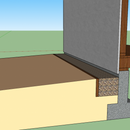Fix for buried stucco
I have a 1960s coastal california home (95062) (3c). The home is wood frame with a stucco exterior. The home sits above a crawlspace.
The stucco is currently buried in the dirt approximately 2-3″ around the entire home. I believe the solution is to dig down, cut the stucco leaving an inch or so in contact with the stem wall and then regrade the site, lowering the dirt everywhere to have proper drainage.
My main problem is the reality of how much dirt I’ll be moving here. Probably a small amount for a construction crew but its a lot for a weekend warrior. Additionally, putting in a pipe for a french drain or similar system does not leave an obvious place to daylight the pipe.
Would digging down and installing a foot or so of aggregate around the perimeter of the building be beneficial? The building has a 16″ overhang around the perimeter which keeps most rain off the stucco but of course not wind-driven rain.
I believe this solution is better than what I currently have but still not ideal.
I’ve attached a before and after image so you can see what I’m suggesting.
GBA Detail Library
A collection of one thousand construction details organized by climate and house part











Replies
Steve,
I'm not sure substituting aggregate for what is there now make any appreciable difference once the stucco is cut back.
My thoughts on the aggregate would be that is dries faster than dirt and helps to keep moisture even further away from the stucco. Point taken on the biggest difference being the cut back stucco, however.
Do you have any problems that you are aware of from this construction detail?
If you don't have them adding gutters may be a good improvement.
You could easily make a problem where none existed.
No problems that we are aware of yet. However, the walls are currently uninsulated and we are planning to insulate. My understanding is that stucco in the dirt isn't good to begin with and insulating the walls can actually make everything worse as it slows the walls drying time if they are sucking up moisture through the stucco.
The house has gutters and the discharge points are ok.
Steve,
I agree that one way or another eliminating the moisture wicking into the wall through capillary action from the buried stucco is a good idea. A couple of other benefits to replacing the soil with aggregate are that it leaves a gap to deter insects infestations, and reduces splash-back.
What you want to watch though is that it doesn't create a path that introduces water against your foundation. Ideally the surface immediately adjacent to the house should slope away and be imperious to moisture.
You could do a kerf cut and install a small flashing to give you the capillary break.
Be careful with gravel against un-sealed foundation. I helped fix a wet basement where the home owner has done exactly this. Had to remove all the gravel and back fill with compacted and sloped limestone screening.
Make sure there is a WRB under your stucco before you insulate. If you don't have one follow the guidelines here:
https://www.greenbuildingadvisor.com/article/insulating-walls-in-an-old-house-with-no-sheathing